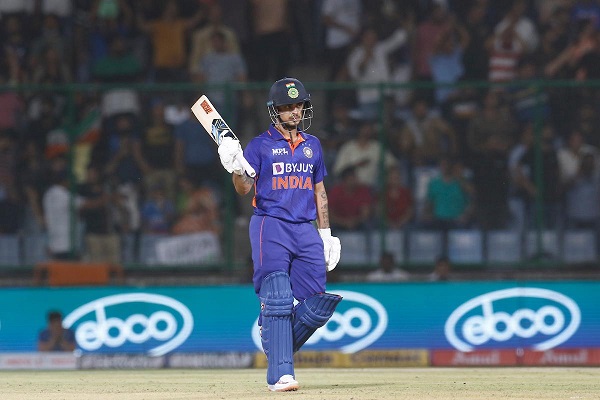New Delhi, (Asian independent) Very rarely, one gets to pick positives from a loss in cricket. Despite India being handed a seven-wicket defeat by South Africa at the Arun Jaitley Stadium on Thursday, they had a big positive to pick — racking up 211/4 in their 20 overs, thanks to a super-aggressive approach with the bat, led by Ishan Kishan’s 76.
India’s approach with the bat was like an action sequence from a Hollywood flick — runs coming thick and fast, first coming through edges and then through scintillating stroke play.
None of the batters tried to play anchor; everyone yearned to be the aggressor and get the big hits, seen from the strike-rates of Kishan (158.33), Gaikwad (153.33), Pant (181.25) and Pandya (258.33), with Iyer’s strike-rate of 133 looking pale.
All five batters got their first boundary within the first 10 balls of the innings, clearly not in a mood to waste time at the crease.
It was in complete contrast to their outdated approach with the bat; one would anchor the innings and rest would play around him, a chief factor in their early exit from the Men’s T20 World Cup last year.
But, in New Delhi, Kishan, captain Rishabh Pant and vice-captain Hardik Pandya later on, showed how going from the word go, devoid of any fear or tension, can bring some phenomenal batting returns despite having a streaky start.
Kishan’s first boundary came when he was beaten in flight by Keshav Maharaj in the opening over, but the outer edge ran past short third man. Luck continued to be on India’s side as a neck-high bouncer from Anrich Nortje saw Ruturaj Gaikwad hook over fine-leg, with the top-edge coming into play.
Kishan and Gaikwad rode their incredibly good fortune through the rest of power-play, amassing 51 runs but never letting go of the aggressive approach despite being tested by some sharp seam movement from the pacers.
After Gaikwad fell to Wayne Parnell, Kishan struggled for fluency till the ninth over when Dwaine Pretorius arrived.
The first ball of the over, width on offer and Kishan played the late cut to get the boundary past fielder at point. When Pretorius tried to correct his length on the final ball, Kishan hammered it through cover to collect another boundary. It was just the over Kishan needed to break free and find his boundary-hitting groove, which reached its high point when Maharaj was re-introduced in the middle overs.
After reaching his fifty in 37 balls by slog-sweeping the left-arm spinner, Kishan unleashed carnage on Maharaj in the 13th over — two more sixes were dispatched to mid-wicket fence and were followed by two boundaries down the ground.
“Initially we knew that we cannot get going on this wicket. My plan was to target the loose balls. In T20Is, powerplay is very important. We need to respect good bowlers as Nortje and Rabada have done really well for their country. My plan was to keep playing my shots and make them change their line and length,” said Kishan about his knock of 76 in the press conference.
Though he holed out to long-on on the last ball of the over in trying to hit another six, Kishan had done his job of setting the base for Pant and Pandya to carry forward the big-hitting spree. He had support from the other end when Shreyas Iyer danced down the pitch thrice to dispatch Tabraiz Shamsi for three sixes towards the leg-side before slowing down and eventually being castled by Pretorius.
“When the left-arm spinner came onto bowl, I told Shreyas that I will take my chances and told him that he can attack when Shamsi was bowling, because you got to be smart at this level. We just planned and it went our way,” were Kishan’s words in the innings break on him and Iyer acing the match-up game against South Africa’s spinners.
Pant and Pandya, made captain and deputy respectively on the eve of the series opener, hit seven boundaries between themselves from overs 17 to 19 with some audacious shots to take India past 210-mark. The duo had spent their match eve effortlessly clearing the ‘V’ in a range-hitting practice and hence, it was no surprise to see them take Pretorius, Parnell and Rabada to the cleaners.
Only time will tell if what India did with the bat at New Delhi will kick-start a change in their approach to batting in the first innings, especially after the rested/injured stalwarts return. But, if one goes by the visuals of Thursday’s innings, they did make gains with the batting formula despite the result not being on their side.








